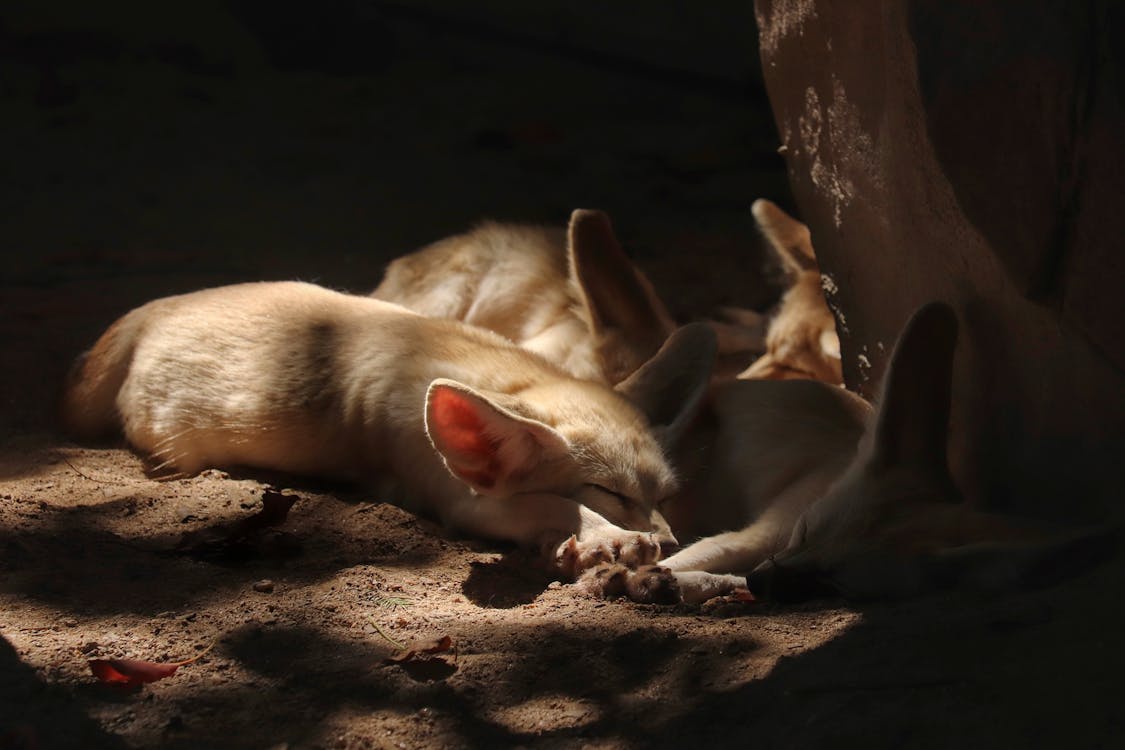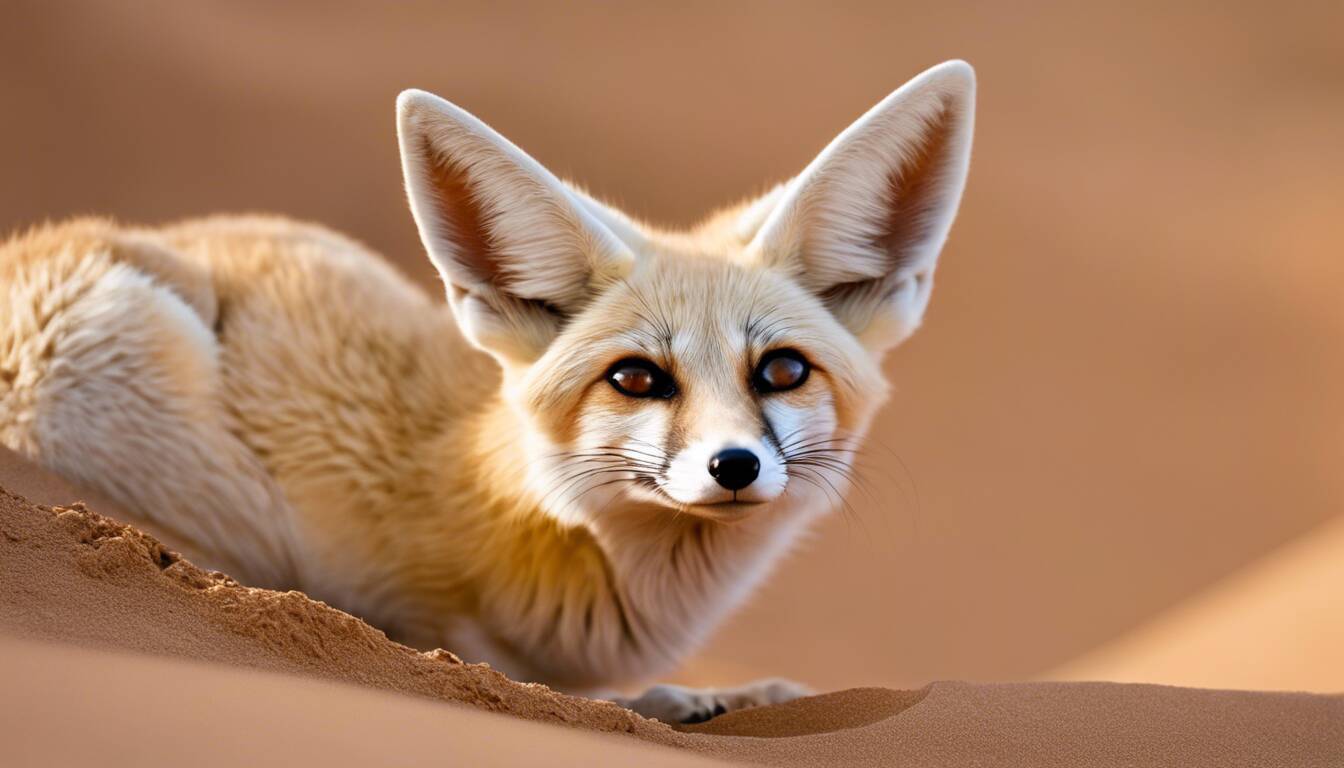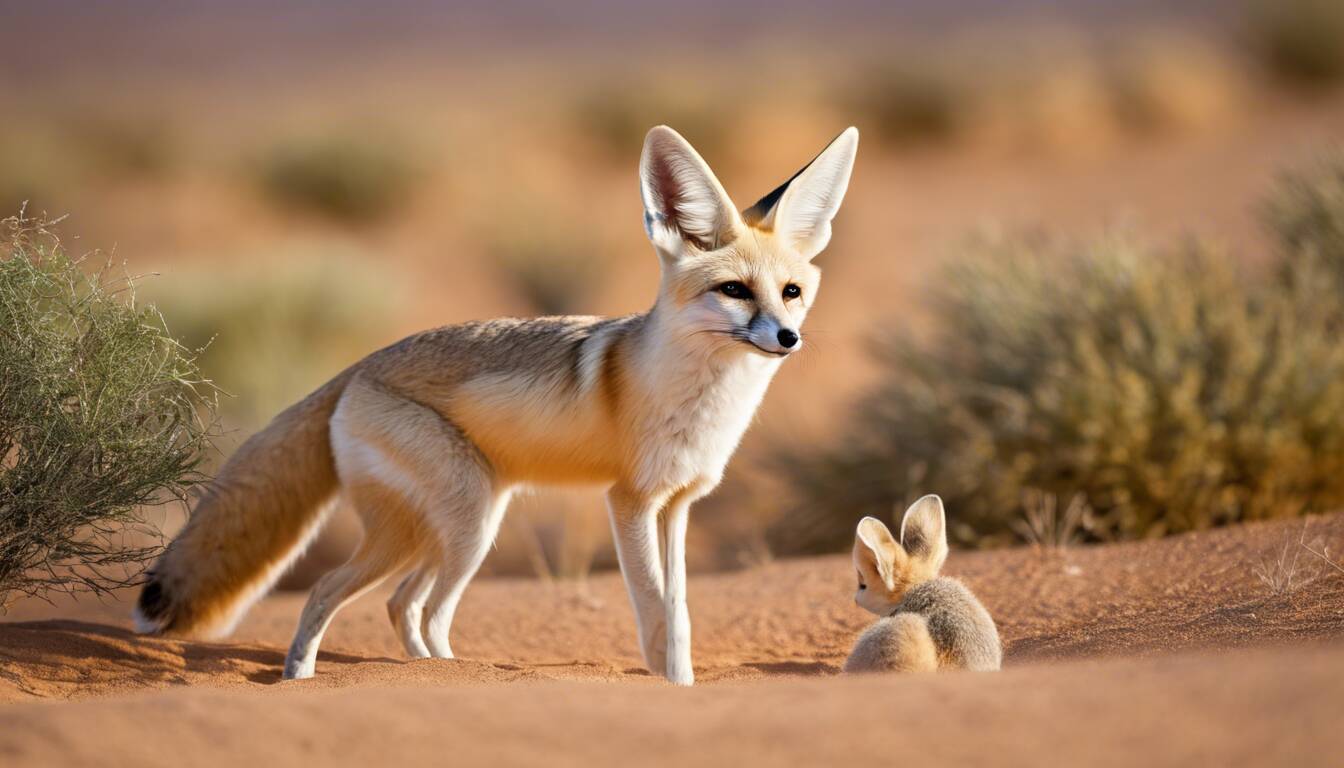We think there are hundreds of thousands of fennec foxes in our vast world. As per the IUCN Red List, these little desert foxes are labeled “Least Concern”, meaning they aren’t close to vanishing right now. Yet, these figures might not be perfect – fennec foxes are shy and their home, the sweeping deserts of North Africa, is a huge place, making it hard to count each one. They’ve also got really big ears which you didn’t expect… yet it helps them survive the searing heat and find food hidden under the sand. But remember, even though they seem safe now, we need to watch over them always.
While precise population figures for fennec foxes are not known, they are currently not threatened by extinction. Their conservation status is classified as Least Concern, indicating that their population is stable.
Current Population of Fennec Foxes
The estimated population of Fennec foxes is quite significant, with several hundred thousand individuals spread across their native habitats. While this may seem like a large number, it’s essential to understand that estimating wildlife populations, especially for elusive species like the Fennec fox, comes with its own set of challenges. The International Union for Conservation of Nature (IUCN) Red List currently classifies the Fennec fox as “Least Concern,” indicating that the species is not presently threatened by extinction. This can provide a sense of relief; however, it’s crucial to interpret this classification with caution.
The “Least Concern” classification doesn’t mean that the Fennec fox population is immune to threats. In fact, there are significant concerns for their future. The primary challenge in assessing their population lies in the elusiveness of these creatures and the vastness of their natural habitat. Desert environments are expansive and can be challenging to survey comprehensively, leading to uncertainties in population estimates.
Moreover, the fennec fox faces threats from wildlife trade and global warming. They are trapped and traded for photo exhibitions, pet trade, and commercial markets. A 2017 study predicts that fennec fox habitat will shrink by more than 40% by the 2050s due to climate change. These factors make it even more complex to accurately gauge their overall population numbers and distribution.
It’s important to consider that population estimates can fluctuate and might not accurately represent the true number of Fennec foxes in existence. Conservation efforts have been focused on ensuring the sustainability of their populations, despite the current “Least Concern” status. Organizations such as San Diego Zoo Wildlife Alliance have been actively involved in conservation efforts for Fennec foxes.
While the “Least Concern” status does offer some reassurance about their immediate survival, ongoing conservation measures are crucial to safeguarding the long-term prospects of these enchanting creatures. Consequently, it’s crucial for researchers and conservationists to continue monitoring these fascinating animals to better understand their numbers and to carry out targeted conservation efforts.
Understanding the challenges in estimating the Fennec fox population sheds light on why careful monitoring and conservation efforts are imperative for their future well-being.
Fennec Foxes’ Natural Habitat
The fennec fox, also known as Vulpes zerda, has found its niche in the unforgiving deserts of North Africa. From the parched expanses of the Sahara to the arid regions of Mauritania and Sudan, these tiny foxes have learned to thrive in environments where water is scarce and temperatures are extreme.
Often found in small sand dunes and vast treeless sand areas with sparse vegetation, the fennec fox has evolved and adapted to withstand the severe desert climate. Their small size enables them to navigate through the challenging terrain with ease.
The adaptation that truly sets them apart is their trademark oversized ears. These extraordinarily large ears serve a dual purpose: not only do they aid in dissipating excess body heat to regulate temperature, but they are also exceptionally sensitive and allow for keen auditory detection of prey moving underground. This offers a crucial advantage when hunting for small rodents and insects—an essential component of their diet.
Given the scarcity of water, fennec foxes have developed noteworthy strategies for survival. Their bodies efficiently extract moisture from their food, notably relying on the moisture content of their prey to supplement their limited water intake. Despite these adaptations, they will readily drink water if it is available.
Ecosystem Interactions
In the harsh desert environment, every aspect of the fennec fox’s physiology and behavior plays a vital role in their survival—much like a finely tuned machine designed for a specific purpose. Their presence significantly influences the delicate balance of desert ecosystems, as they primarily feed on small mammals, insects, and vegetation.
Their interaction within this ecosystem plays an integral part in controlling rodent populations and preventing overgrazing by herbivores on sparse desert plants. This makes them important contributors to maintaining the ecological balance within their habitats.
Their burrowing behavior doesn’t just provide protection; it also creates shelter for other animals that may utilize abandoned dens, thus serving as unintentional architects in shaping the desert landscape.
Climate Preferences
Just as camels are perfectly adapted to endure long periods without water due to their humps functioning as fat reserves, fennec foxes have adapted to minimize water loss—a testament to how species adapt to thrive within their unique environments.
Fennec foxes are primarily nocturnal, showing heightened activity during the cooler nighttime hours when temperatures are less punishing. Their fur retains minimal heat while providing insulation against cold nights—a marvel of natural engineering that equips them to brave the temperature extremes prevalent in desert climates.
Geographical distribution: Fennec Foxes are found in North Africa, primarily in arid and semi-arid regions, with temperatures ranging from 68°F to 104°F (20°C to 40°C).
Understanding the intricate ways these creatures have adapted to such demanding environments provides us with a profound appreciation for nature’s incredible capacity for resilience and survival.
See Related: Exploring the Diet and Food Chain of Fennec Foxes in Desert Habitats
Facing Extinction: Threats to Fennec Fox Survival

As much as we admire these adorable creatures, it’s vital to acknowledge the very real threats they face in their daily struggle for existence. One of the most significant dangers comes from humans, unfortunately. Fennec foxes often fall victim to trapping, either for sale as exotic pets or to be put on display for tourists. The captivating beauty of these foxes makes them popular targets for those seeking profit rather than grasping the importance of leaving them in their natural habitat.
Expansion of human settlements also poses a grave threat to the survival of Fennec foxes. As human populations grow, more and more land is needed for construction and agriculture, leading to the destruction and fragmentation of the foxes’ natural habitats. But it’s not just about losing living space; there are also fearsome predators that pose a direct threat to these foxes, such as caracals, jackals, striped hyenas, and even African horned owl species like the Pharaoh eagle-owl.
Habitat Destruction and Fragmentation
Habitat loss is devastating to any species, but it’s particularly challenging for animals like the Fennec fox that rely heavily on specific arid desert habitats. Their ability to survive depends on having enough space with the right resources available. When human activities cause this space to shrink or break apart, it becomes increasingly difficult for these foxes to find food and shelter, ultimately jeopardizing their survival.
The pressure from agricultural and urban development has pushed many species, including the Fennec fox, towards the brink of endangerment. What was once a vast open desert is now increasingly intersected with roads, farms, and towns. This kind of interference is especially detrimental to creatures with specific needs like the Fennec fox.
Imagine if your neighborhood suddenly turned into a noisy construction site and you had nowhere else to go—no peace and quiet anymore! That’s what it feels like for these foxes when their homes are disrupted by construction projects and motorways.
Understanding these threats allows us to better appreciate the importance of conservation efforts aimed at protecting the remaining Fennec fox populations from further harm. By addressing issues such as overexploitation and habitat loss, we can hope to secure a future where these enchanting creatures continue to thrive in their natural environment.
The intricate dance between nature and human activities can have far-reaching consequences for wildlife. Now let’s explore how human actions directly impact the daily life of Fennec foxes.
How Human Activities Impact Fennec Foxes
Human activities have a profound impact on the delicate balance of the fennec fox’s ecosystem. The rapid expansion of urban areas has led to the destruction and fragmentation of their natural habitats. As cities and towns expand into previously untouched areas, the landscape is drastically altered, ultimately encroaching upon the territories where these elusive creatures once thrived.
The loss of habitat due to human development results in a critical reduction in available food sources and shelters for the fennec foxes. As vegetation is cleared and replaced with buildings, roads, and other infrastructure, the foxes lose crucial hunting grounds and secure locations for raising their young. This loss of habitat can push the foxes into more dangerous areas, increasing their vulnerability to predators and human-related dangers.
The spread of road networks through previously undisturbed areas further compounds the challenges faced by fennec foxes. These networks fragment the foxes’ territories, increasing the risk of mortality due to collisions with vehicles. The elegant agility and speed that aid them in escaping predators are no match for fast-moving cars and trucks. Tragically, vehicle collisions are a leading cause of mortality for many wildlife species, including the fennec fox.
It’s essential for us to recognize that these impacts are not isolated events; they are part of a larger pattern of human expansion affecting numerous species worldwide. The consequences have far-reaching effects on ecosystems, disrupting natural balances and endangering the unique biodiversity that enriches our planet.
As we continue to expand our urban landscapes, it’s crucial that we consider the environmental toll this takes on vulnerable species like the fennec fox. It requires a delicate balance between human progress and the preservation of vital habitats for these distinctive creatures.
Understanding the repercussions of human activities on fennec fox populations provides valuable insight into the conservation efforts necessary to support their survival in an evolving world.
Conservation Efforts to Protect Fennec Foxes
The conservation of Fennec foxes involves a multifaceted approach that addresses both the direct and indirect threats to their survival. One core strategy is habitat preservation, recognizing the survival of these foxes is inherently linked to the conservation of their natural environment. Conservation organizations and wildlife agencies collaborate to establish and maintain protected areas where Fennec foxes can thrive without the threat of habitat destruction.
Community engagement is another crucial aspect of conservation efforts. Local communities play a pivotal role in ensuring the long-term survival of Fennec foxes. By engaging with these communities, conservationists promote coexistence between humans and Fennec foxes. Educational programs raise awareness about the importance of Fennec fox conservation, fostering a sense of pride and responsibility among local residents in protecting these unique creatures.
Furthermore, anti-poaching measures are implemented to combat illegal hunting and trade of Fennec foxes. Anti-poaching patrols operate in critical areas to prevent poaching activities and safeguard the foxes from being targeted for the exotic pet trade or other illicit purposes. By reducing illegal trade, conservationists aim to curb the detrimental impact on Fennec fox populations, contributing to their overall protection and well-being.
It’s paramount that ongoing efforts prioritize proactive measures to reduce human-induced threats on Fennec fox populations. Through collaborative initiatives and sustained dedication, the mission to protect these enchanting creatures can thrive, ensuring their existence for generations to come.
With concerted efforts and unwavering dedication, these initiatives hold promise for securing a brighter future for the captivating Fennec fox population. Let’s now turn our attention to evaluate the effects of these endeavors on the growth of Fennec fox populations.
The Impact of Initiatives on Fennec Fox Population Growth
The conservation efforts aimed at safeguarding Fennec foxes and their habitats have yielded positive outcomes, illustrating encouraging signs of progress. By reducing illegal trapping and creating protected areas, the natural habitats of these tiny foxes have been preserved, giving them a better chance at survival. Additionally, initiatives to minimize conflicts between humans and wildlife, such as the creation of wildlife corridors and the introduction of sustainable livelihoods for local communities, have contributed to fostering a more harmonious coexistence between people and foxes.
The implementation of wildlife corridors, which serve as safe passageways for animals to move between different habitats, has proved to be particularly beneficial. These corridors provide a means for Fennec foxes to travel between fragmented areas without encountering human disturbances or dangerous obstacles, thereby increasing their chances of finding food, mating partners, and suitable den sites.
Furthermore, the development of sustainable livelihoods for local communities not only reduces their dependence on resources from the foxes’ habitats but also enhances their awareness and appreciation of the importance of preserving these environments. As a result, the pressure placed on the natural resources within Fennec fox habitats is alleviated, lessening the impact on the delicate ecosystems that sustain these remarkable creatures.
Constant assessment allows conservationists to gauge the effectiveness of various strategies in real-time and make necessary adjustments in response to changing circumstances or emerging challenges. By remaining vigilant and flexible, conservation efforts can consistently evolve to address the dynamic needs of Fennec fox populations and their ecosystems.
In order to ensure that the positive impacts continue to support the growth and stability of Fennec fox populations, it is imperative for stakeholders to remain committed to long-term monitoring and adaptive management. By doing so, we can bolster the resilience of these unique creatures and promote a healthier balance within their natural habitats.
The combined efforts aimed at protecting Fennec foxes have undeniably shown promising results; however, there is still much work to be done to secure a sustainable future for these enchanting animals.


